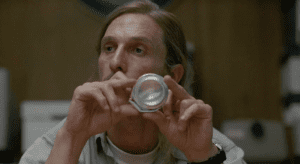Tony Jones recently posted something from theologian Nicholas Wolterstoff that bugged me a bit.
Wolterstorff is a really, really smart fellow. He didn’t get to be emeritus professor of philosophical theology at Yale University by accident. Plus, I encountered his Until Justice and Peace Embrace at just the right time for it to make a deep impression. So I approach his thoughts with both respect and gratitude.
Having said that, though, this still strikes me as Linelander nonsense:
If we are to accept this picture of God as acting for the renewal of human life, we must conceive of him as everlasting rather than eternal. God the Redeemer cannot be a God eternal. This is so because God the Redeemer is a God who changes. And any being which changes is a being among whose states there is temporal succession. Of course, there is an important sense in which God as presented in the Scriptures is changeless: he is steadfast in his redeeming intent and ever faithful to his children. Yet, ontologically, God cannot be a redeeming God without there being changeful variation among his states.
… if God were eternal he could not be the object of any human action whatsoever.
I let that pass, though, because I’m way out of my depth here. The relationship between time and eternity, or between change and eternity, isn’t something I’m qualified to speak about with any confidence because: A) I am a temporal creature whose every thought is bound by my temporal being; and B) I’m an English major and not a physicist, and reading Hawking’s popular books and hearing a bunch of NPR interviews with Brian Greene* doesn’t change that.
But then yesterday I heard the very same idea, again, in very similar language. This time it wasn’t coming from a Yale theologian, but from a fictional detective — from Rustin Cohle/Matthew McConaughey/Nic Pizzolatto on True Detective.
And in that context, I think, an English major might just have a better set of tools for making sense of this than a theologian or a physicist.
Rust Cohle gets his Wolterstorff on in one of the show’s 2012 interview scenes — scenes in which, it seems, we can’t be sure that anything he says can be taken at face value. So we can’t be sure if this is what Cohle actually believes or if it’s just him riffing to further confuse the “present-day” detectives he’s interviewing (while convincing them they’re interviewing him). Cohle, impatient and disgusted with these “company men,” offers a short philosophical rumination on “membrane theory,” crushing a beer can into the “flat circle” of time as an illustration:
It’s like, in this universe, we process time linearly. Forward. But outside of our space time, from what would be a fourth dimensional perspective, time wouldn’t exist. And from that vantage, could we attain it, what we’d see is our space time would look flattened like a single sculpture of matter in a super position, every place it ever occupied. Our sentience just cycling through our lives like carts on a track. See, everything outside our dimension – that’s eternity…eternity looking down on us. Now to us, it’s a sphere. But to them, it’s a circle.
… In eternity where there is no time, nothing can grow, nothing can become, nothing changes.
I don’t understand M-theory, and I haven’t read Robert Chambers so I can’t race down the rabbit-hole of all the Yellow King and Carcosa theories proliferating online. But I have read — and re-read — Edwin Abbott’s Flatland, and I recognize Flatland allusions when I hear them. Whether or not what Cohle is describing there is an accurate description of M-theory I don’t know, but it’s straight out of Abbott’s weirdly wonderful little book.
 The hero of Flatland, our narrator, is a two-dimensional square who lives in the two-dimensional world of the title. After some odd social satire about the various shapes who live in Flatland, we follow Mr. Square as he comes across the one-dimensional beings who live in the even-more dimensionally constrained world of Lineland. The Linelanders are points on a line. Meeting a two-dimensional square for the first time, they’re unable to perceive him as he fully is. To them he appears just as they do, as a single point on the line of Lineland. Mr. Square tries to explain to them that he’s more than that — that he has a second dimension and is able to move north and south as well as east and west, but this blows their little Linelander minds and they can’t make any sense of it. North and south? Two dimensions? That’s nonsense.
The hero of Flatland, our narrator, is a two-dimensional square who lives in the two-dimensional world of the title. After some odd social satire about the various shapes who live in Flatland, we follow Mr. Square as he comes across the one-dimensional beings who live in the even-more dimensionally constrained world of Lineland. The Linelanders are points on a line. Meeting a two-dimensional square for the first time, they’re unable to perceive him as he fully is. To them he appears just as they do, as a single point on the line of Lineland. Mr. Square tries to explain to them that he’s more than that — that he has a second dimension and is able to move north and south as well as east and west, but this blows their little Linelander minds and they can’t make any sense of it. North and south? Two dimensions? That’s nonsense.
Shortly after that frustrating encounter, our narrator meets a circle who’s behaving strangely. This circle has the odd ability to change its size, growing and shrinking its circumference. The circle explains to our narrator that this is because he’s not a circle at all, but a three-dimensional sphere. He only appears to be changing in size because only the edge of the sphere is visible to Flatlanders as he moves up and down through the plane of their world.
“Up and down” makes no sense to Mr. Square, who insists on reinterpreting those strange new words to mean north and south. Three dimensions? That’s nonsense.
So the sphere does something wonderful. He takes the square up — up and out of Flatland and into the third dimension. From that vantage point, looking down on the plane of his two-dimensional world, our narrator is able to see his entire world — everything, even the insides of houses and the insides of his fellow-Flatlanders.
At this point our narrator’s mind is well and truly blown. He has an epiphany, or he goes mad, or both. He has come to understand up and down in a way that he was unable to get the Linelanders to understand north and south, and now he wants to understand more.
Let’s keep going, he says to the sphere. The third-dimension is amazing, transcendent, so let’s see what the next dimension looks like, and the next, and the next. This angers the sphere. Four dimensions? That’s nonsense.
Abbott’s parable is useful for helping us to understand what it is that we cannot understand. We can pity the poor Linelanders for their cramped lack of perspective and the way it traps their perceptions in a cell that prevents them from being able to grasp the reality of north and south, but we can also see that we are, ourselves, just prisoners of a somewhat larger cell. Like the Linelanders, we’re unable to see or even to imagine that there is more than our temporally bound existence can perceive, but that doesn’t mean that this is all there is.
Which is why I think we need to be very circumspect (literally) and very humble when it comes to making big sweeping claims about eternity and time and how they relate to one another. It’s also why I think Wolterstorff’s assertion that “if God were eternal he could not be the object of any human action whatsoever” is flatly wrong. And so is Cohle’s statement that “In eternity where there is no time, nothing can grow, nothing can become, nothing changes.” Both of those statements strike me as Linelander nonsense. Or, rather, as Linelanders dismissing as nonsense anything that exceeds their east-west-is-all-there-is perspective of reality.**
The certainty that growth, change and becoming cannot be possible in eternity is a variation of the Linelander’s certainty that there cannot possibly be any such thing as north and south.
Cohle’s Linelander nonsense is, I think, more interesting than Wolterstorff’s because, unlike the Yale theologian, Cohle is a fictional character. It’s more interesting because Cohle almost seems to realize that he is, in fact, a fictional character.
So let’s set aside M-theory and string theory and multiple dimensions and all of that. Set aside physics and metaphysics and the dubious theology of time. Let’s talk about storytelling.
True Detective has prompted more convoluted theorizing than any show since Lost, as Alex Pappademas writes at Grantland:
I’m still not convinced that True Detective isn’t actually a media virus that causes outbreaks of hysterical Doc Jensen–ism.
Jensen (first name Jeff) is the Entertainment Weekly writer who blogged voluminously and obsessively about Lost during that show’s run, chasing down and annotating even the smallest textual references to pop culture or philosophy, while spinning out theory after convoluted theory about Where This Was All Going. He became Lost fandom’s theoretician-in-chief, and as a no less fixated Lost fanatic, I devoured everything he wrote about the show, even when it seemed fanciful or far-fetched.
Those two shows share little in common in terms of plot, but they’re very similar in terms of structure. Both provide a mix between “present-day” events and flashbacks to a past that seems, at first, incompatible with what we’re seeing “now.” That, I think, is what prompted all that extravagant speculation about Lost, and what is now doing the same thing for True Detective. Both present many worthy mysteries — what is the smoke monster? who killed Dora Lange? — but it’s the larger mystery that has us hooked: How do these disparate strands of narrative all fit together? Or, put another way, will this all make sense when viewed as a whole?
Viewers are forced to speculate — to seek out clues, to parse every line and every shot — because that is all we are able to do from our present vantage point. We cannot make sense of the whole because we cannot see the whole — we don’t yet know how it ends. We’ve seen the beginning and we’re watching the middle, but without that ending we can’t be sure that we’ve really understood anything we’ve seen so far. As David Simon put it, “It doesn’t mean anything until there’s a beginning, middle and an end.”
Simon isn’t saying that we don’t understand the meaning of the end because we haven’t seen the end yet. He’s saying that even though we’ve “seen” the beginning and the middle, we don’t understand what those mean yet because we haven’t seen the end. Without knowing the ending, we cannot know what the beginning or the middle means either.
The structure of True Detective constantly reminds us of this, forcing us to realize that what we have not yet seen prevents us from fully understanding what we have seen and what we are seeing. That’s a fun place to be as the viewers of a television show. It’s less fun if you’re one of the characters on that show. And one of the things True Detective does very well is the meta-fictional bit of reminding us that we have more in common with such characters than we might like to admit.
“Cohle describes the possibility of other dimensions existing, and he says that’s what eternity is,” Pizzolatto continued. “He says that if somehow you existed outside of time, you’d be able to see the whole of our dimension as one superstructure with matter superimposed at every position it had ever occupied. He says that the nature of the universe is your consciousness, and it just keeps cycling along the same point in that superstructure: when you die, you’re reborn into yourself again, and you just keep living the same life over and over. He also explains that from a higher mathematical vantage point, our dimension would seem less dimensional. It would look flattened, almost.”
Pizzolatto took a bite of his branzino. “Now, think about all the things Cohle is talking about,” he said as he finished chewing. “Is he a man railing against an uncaring god? Or is he a character in a TV show railing against his audience? Aren’t we the creatures of that higher dimension? The creatures who can see the totality of his world? After all, we get to see all eight episodes of his life. On a flat screen. And we can watch him live that same life over and over again, the exact same way.”
Fun stuff, even if it’s just a variation of a theme we’ve seen before in everything from St. Elsewhere to Star Trek to Shakespeare. But there are a few glitches there in what Andrew Romano describes as Pizzolatto’s transforming “M-theory into a metaphor for television — and television, perhaps, into a metaphor for existence itself.”
First there’s the mistaken notion that we are able to see “the totality” of Rust Cohle’s world. That isn’t what our flat screens show us. We see his world from perspectives that are unavailable to him, but we don’t see anything like the “totality” of it. We see only what we are shown, and that’s not all there is. (I’d guess that McConaughey knows this, since it’s something that writers sometimes forget, but actors can’t avoid remembering.) It’s a distortion, then, to imagine that what we are shown of these characters is the totality of their world. And it’s a particular kind of distortion — a flattening.
And that’s the second, bigger, problem with what Pizzolatto is saying there about how our dimension or the totality of our world would appear “from a higher mathematical vantage point.” It would not “look flattened, almost.” That’s an analogy for how it would appear from that higher vantage point, but not how it would actually appear. We can’t comprehend how it would actually appear, so we’re stuck with such analogies — and with all the distorting, flattening baggage they carry. The mistake comes when we confuse those analogies for reality — when we forget that they tell us about the limits of what we are able to perceive rather than about the limits of what there is to be perceived.
Any attempt by us to think of how our world appears from a “higher vantage point” is bound to wind up sounding like something out of Flatland. Just consider that word “higher,” which has already led us astray. It’s the wrong word — an inadequate and inaccurate word. We would not be looking “down” at our world from some “higher” vantage point, but we’re forced to resort to such three-dimensional words because those are all we know, just as the narrator in Flatland insisted that “up and down” must just be other words for north and south. Lacking any other language, we revert to this same analogy of the sphere hovering “above” a flat plane of existence. That’s fine as an analogy — it’s like that, but it is not that.
This is why alarm bells go off for me whenever I hear someone — whether it be a respected theologian or a fictional detective — use the word “linear” when talking about time and eternity.
“We process time linearly, forward” Rust Cohle says. That’s descriptively true. But then he continues: “But outside of our space time, from what would be a fourth dimensional perspective, time wouldn’t exist.” And that’s not descriptively true. Nor is it a necessary logical conclusion. East and west do not cease to exist when we move from Lineland to Flatland. North and south do not cease to exist when we move from Flatland into a third dimension. “Linear” is not exclusively meaningful for the linear world of Lineland where it describes the totality of that world. Lines do not cease to exist when we move on to planes or to cubes or to whatever comes after that.
And similarly, I do not think that growth, change and becoming would cease to exist if we could somehow move beyond our present linear, forward-only existence as temporal beings. From a non-linear viewpoint, time …
It got away from me, yeah.
– – – – – – – – – – – –
* The ones on “Fresh Air” and “On Being” are particularly fun. You should choose to listen to them, even though Greene doesn’t think you actually have free will to choose such things.
** We should note, too, that Wolterstorff is a Reformed theologian — a Calvinist. While his version of this is subtler and more sophisticated than that of the pop-theologians of the Calvinist blogosphere (Piper, Driscoll, the Mohler crowd, etc.) it still means that ultimately he shares with Rust Cohle a darkly fatalistic view of a profoundly unjust universe. Yes, I realize that Calvinists all say that their fatalistic universe is ultimately just, but to do so they also have to redefine “just” in a way that makes the eternal conscious torment of the vast majority of the human species something that could be defended as justice, and, well, at that point they’ve lost me. If I’m going to embrace the idea of existence as an eternity of endless suffering, I’d rather side with Cohle than with the blasphemous assertion that a “loving” God deserves the “credit” for this. I’d rather think of love as an aberration, an accident or an illusion than allow it to be redefined as something so monstrously “holy.”
My point here, though, is that fatalism is inescapable once you embrace the static view of eternity that Wolterstorff and Cohle both describe. That’s true whether you go with Cohle’s flattened M-theory variant or with the Calvinist doctrine of predestination. I suspect that Wolterstorff’s musings on time and eternity may be, in some way, an attempt to salvage that doctrine by inventing a retroactive continuity to justify it. That’s a hopeless endeavor, though, since predestination itself is a failed attempt to retcon reality — an attempt made by characters in the middle of a story who do not yet know the end of it.
Both versions of this fatalism — Cohle’s and Calvin’s — reflect the meta-fictional idea that, as Romano writes of True Detective, “everything is a story.” And both do so in a way that suggests that we’re just characters and playthings in a story being told by someone else or something else.
Screw that. Choose. Love. Choose love. Write your own story.












